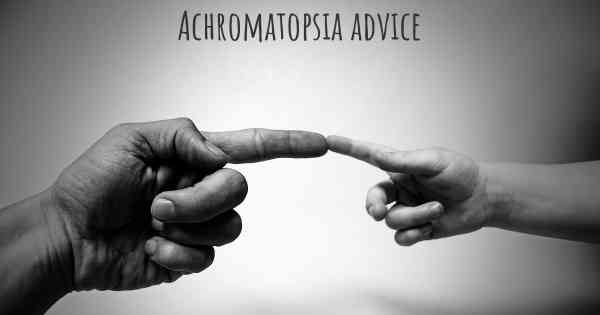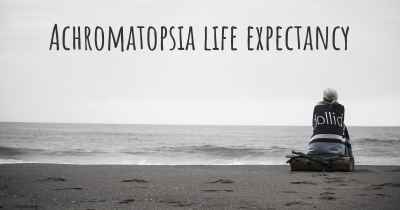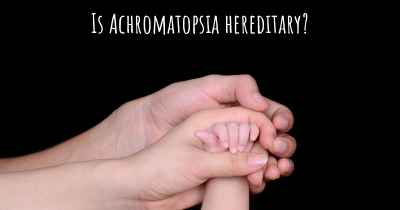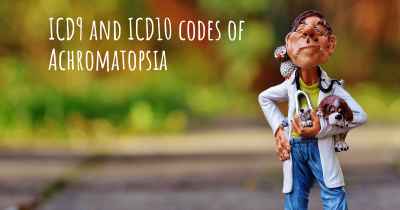Which advice would you give to someone who has just been diagnosed with Achromatopsia?
See some advice from people with experience in Achromatopsia to people who have just been diagnosed with Achromatopsia

Advice for Someone Diagnosed with Achromatopsia
Receiving a diagnosis of Achromatopsia can be overwhelming and may raise many questions and concerns. Achromatopsia, also known as total color blindness, is a rare genetic condition that affects the ability to see colors and causes other visual impairments. While there is currently no cure for Achromatopsia, there are various strategies and resources available to help manage the condition and improve quality of life.
1. Seek Support and Education
It is crucial to connect with others who have Achromatopsia or similar visual impairments. Joining support groups or online communities can provide a wealth of knowledge, advice, and emotional support. These communities can help you navigate the challenges associated with Achromatopsia and offer insights into coping mechanisms and assistive technologies.
2. Consult with a Low Vision Specialist
Low vision specialists are professionals who specialize in helping individuals with visual impairments make the most of their remaining vision. They can assess your specific needs and recommend appropriate visual aids, such as specialized glasses, contact lenses, or magnifiers. These devices can enhance your visual experience and improve your ability to perform daily tasks.
3. Adapt Your Environment
Modifying your environment can significantly improve your daily life. Consider implementing the following changes:
- Lighting: Ensure your living and working spaces are well-lit. Use natural light whenever possible and supplement it with artificial lighting as needed. Avoid harsh glares or direct sunlight that may cause discomfort.
- Contrast: Increase contrast in your surroundings by using contrasting colors for furniture, walls, and objects. This will help you differentiate between different elements and navigate your environment more easily.
- Labeling: Label frequently used items, such as clothing, food containers, and household products, with high-contrast labels or tactile markers. This will assist you in identifying and organizing your belongings.
- Organization: Keep your living and working spaces organized and clutter-free. This will minimize visual distractions and make it easier for you to find and access items.
4. Explore Assistive Technologies
Advancements in technology have opened up a world of possibilities for individuals with visual impairments. Consider exploring the following assistive technologies:
- Screen Readers: Screen readers are software programs that convert text into speech or braille. They can read out text from computers, smartphones, and other digital devices, enabling you to access written information.
- Color Identification Apps: There are smartphone apps available that can help you identify colors by using the device's camera. These apps can be useful when differentiating between objects or selecting matching clothing.
- Electronic Magnifiers: Electronic magnifiers, also known as video magnifiers, can enlarge text and images, making them easier to read and view. They come in various forms, including handheld devices and desktop systems.
5. Develop Coping Strategies
Living with Achromatopsia requires developing coping strategies to navigate daily challenges. Here are a few techniques that may help:
- Orientation and Mobility Training: Consider undergoing orientation and mobility training with a specialist. They can teach you techniques to navigate unfamiliar environments, use public transportation, and improve your spatial awareness.
- Use Visual Cues: Utilize visual cues, such as patterns, textures, and shapes, to identify objects or landmarks. For example, you can use tactile markers on stair edges or door frames to help you navigate your surroundings.
- Ask for Assistance: Don't hesitate to ask for help when needed. Inform your friends, family, and colleagues about your condition, and let them know how they can support you in various situations.
6. Take Care of Your Emotional Well-being
Receiving a diagnosis of Achromatopsia can be emotionally challenging. It is essential to prioritize your mental health and seek support when needed. Consider the following:
- Therapy: Engage in therapy or counseling to help you process your emotions and develop coping mechanisms. A mental health professional can provide guidance and support tailored to your specific needs.
- Join Support Groups: Connect with others who have Achromatopsia or similar conditions. Sharing experiences and challenges with individuals who understand can provide a sense of belonging and emotional support.
- Practice Self-care: Engage in activities that bring you joy and relaxation. This could include hobbies, exercise, meditation, or spending time with loved ones.
Conclusion
Receiving a diagnosis of Achromatopsia may initially feel overwhelming, but with time, support, and the right resources, you can adapt and lead a fulfilling life. Seek support from others, consult with professionals, adapt your environment, explore assistive technologies, develop coping strategies, and prioritize your emotional well-being. Remember, you are not alone, and there is a community ready to support you on this journey.








